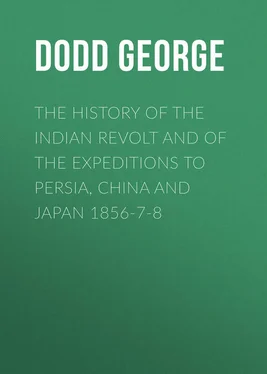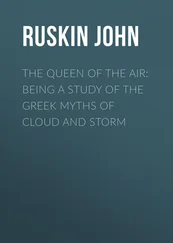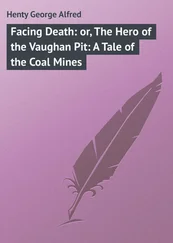George Dodd - The History of the Indian Revolt and of the Expeditions to Persia, China and Japan 1856-7-8
Здесь есть возможность читать онлайн «George Dodd - The History of the Indian Revolt and of the Expeditions to Persia, China and Japan 1856-7-8» — ознакомительный отрывок электронной книги совершенно бесплатно, а после прочтения отрывка купить полную версию. В некоторых случаях можно слушать аудио, скачать через торрент в формате fb2 и присутствует краткое содержание. Жанр: foreign_antique, foreign_prose, на английском языке. Описание произведения, (предисловие) а так же отзывы посетителей доступны на портале библиотеки ЛибКат.
- Название:The History of the Indian Revolt and of the Expeditions to Persia, China and Japan 1856-7-8
- Автор:
- Жанр:
- Год:неизвестен
- ISBN:нет данных
- Рейтинг книги:3 / 5. Голосов: 1
-
Избранное:Добавить в избранное
- Отзывы:
-
Ваша оценка:
- 60
- 1
- 2
- 3
- 4
- 5
The History of the Indian Revolt and of the Expeditions to Persia, China and Japan 1856-7-8: краткое содержание, описание и аннотация
Предлагаем к чтению аннотацию, описание, краткое содержание или предисловие (зависит от того, что написал сам автор книги «The History of the Indian Revolt and of the Expeditions to Persia, China and Japan 1856-7-8»). Если вы не нашли необходимую информацию о книге — напишите в комментариях, мы постараемся отыскать её.
The History of the Indian Revolt and of the Expeditions to Persia, China and Japan 1856-7-8 — читать онлайн ознакомительный отрывок
Ниже представлен текст книги, разбитый по страницам. Система сохранения места последней прочитанной страницы, позволяет с удобством читать онлайн бесплатно книгу «The History of the Indian Revolt and of the Expeditions to Persia, China and Japan 1856-7-8», без необходимости каждый раз заново искать на чём Вы остановились. Поставьте закладку, и сможете в любой момент перейти на страницу, на которой закончили чтение.
Интервал:
Закладка:
Rivers and harbours had shared in the attention bestowed on irrigation and canal navigation. The Ganges had been opened to river steamers before 1848, and it only remained to advance in the same line of improvement. The Indus, by the conquest of the Punjaub, had been made a British river almost from the Himalaya down to the ocean; steamers had been placed upon it; and it had become a direct route for troops and travellers to many parts of Northern India, before attainable only by the Calcutta route. All the rivers in the upper part of the Punjaub had been surveyed, with a view to the determination of their capabilities for steam-navigation. No sooner was Pegu acquired, than steamers were placed upon the Irrawaddy, the great river of that country; and short canals of junction between various rivers had been so planned as to give promise of a complete line of river-steaming from Bassein to Moulmein. Arrangements had been made for placing steamers upon the river Burhampooter or Brahmaputra, to connect Assam with the Bay of Bengal. Extensive works had been commenced to improve the navigation of the Godavery. The channels that lead from Calcutta through the Sundurbunds to the sea had been enlarged; and a great bridge over the Hoogly near the city had been planned. The port of Bombay had been greatly improved, and large works for water-supply commenced. At Kurachee, at Madras, at Singapore, at Rangoon, and at other places, engineering improvements had been made to increase the accommodation for shipping.
We follow the Marquis of Dalhousie from the river to the land, and trace with him the astonishing length of new road constructed or planned during his administration. A great trunk-road from Calcutta to Delhi had been extended nearly to the Sutlej; and when the Punjaub became a British possession, plans were immediately marked out for prolonging the same road to Loodianah, Umritsir, Lahore, Jelum, Attock, and Peshawur – thus forming, if all be completed, a magnificent road 1500 miles in length from Calcutta to the Afghan frontier, available both for commercial and military operations. The difficulties of crossing so many broad rivers in Northern India is immense, and the cost great; but the road, as the minute tells us, ‘will repay a thousandfold the labour and the treasure it has cost.’ Then, fine roads had been formed from Patna to Gya, from Cuttack to Ungool and Sumbhulpore, from Dacca to Akyab, and thence towards Aracan and Pegu; while vast systems of roads had been brought under consideration for Pegu, the Punjaub, Sinde, and other newly acquired regions. Engineers had been employed to plan a road from Simla up to the very Himalaya itself, to connect India with Tibet; as it would greatly improve the social position of all the native tribes near it. When Pegu was attacked, and when a military force was sent thither overland from Calcutta, hundreds of elephants were employed to force a way through the forests and roadless tracts between Aracan and Pegu; but by the spring of 1855 a road had been formed, along which a battalion could march briskly on foot.
The Marquis of Dalhousie was not in a position to say so much concerning railways in India as ordinary roads. Although railways were brought under the consideration of the Company in 1843, nothing was done regarding them till 1849, when a contract was entered into with a separate company to construct a certain length of railway which, if continued, would connect Calcutta with the north and northwest of India. In the spring of 1853 the marquis recommended a bold line of policy in these matters: the sanction and support, in every available way, of great lines of railway to connect Calcutta with Lahore, Bombay with Agra, Bombay with Madras, and Madras with the Malabar coast. A qualified approval of these schemes had been accorded by the East India Company, and engagements to the extent of ten millions sterling had been made for a railway from Delhi to Burdwan: a line from Burdwan to Calcutta having been opened in 1855. The governor-general, not dreaming of mutinies and rebellions, named the year 1859 as the probable time of finishing the iron route from Calcutta to Delhi. Besides these engagements with the East India Railway Company in the Bengal presidency, contracts had been made with the Great India Peninsula Company for a railway from Bombay to the Ghaut Mountains; and another with the Bombay and Central India Company for a railway from Bombay to Khandeish and Nagpoor, and for another from Surat to Ahmedabad. On the eastern coast, the government had arranged with the Madras Railway Company for lines from Madras to the Malabar coast, viâ Coimbatore, and from Variembaddy to Bangalore. The English nation has long blamed the East India Company for a dilatory policy in regard to railways; but all we have to do in this place is, on the authority of the governor-general, to specify in few words what had been done in the years immediately preceding the outbreak.
The electric telegraph – perhaps the grandest invention of our age – found in India a congenial place for its reception. Where the officials had no more rapid means of sending a message to a distance of a thousand miles than the fleetness of a corps of foot-runners, it is no marvel that the achievements of the lightning-messenger were regarded with an eager eye. An experimental line of electric telegraph was determined on, to be carried out by Dr (now Sir William) O’Shaughnessy; and when that energetic man made his report on the result in 1852, it was at once determined to commence arrangements for lines of immense length, to connect the widely separated cities of Calcutta, Madras, Bombay, and Peshawur, and the great towns between them. It was a grand idea, and was worthily realised; for by the month of March 1854 an electric wire of 800 miles was established between Calcutta and Agra; by the month of February 1855, the towns of Calcutta, Agra, Attock, Bombay, and Madras were placed in telegraphic communication by 3000 miles of wire, serving nearly forty towns on the way; and by the beginning of 1856 another length of 1000 miles was added, from Attock to Peshawur, from Bangalore to Ootacamund, and from Rangoon to the Burmese frontier. Many works of great magnitude were required; there were few good roads for the workmen to avail themselves of; there were few bridges; there were deadly jungles to be passed; there was every variety of foundation, from loose black soil to hard rocky wastes; there were seventy large rivers to be crossed, either by cables in the water, or by wires extended on the tops of masts; there was a cable of two miles required to cross the Toongabudra, and one of three miles to cross the Sone – and yet the entire work was comprised within a cost of 500 rupees or £50 per mile: perhaps the wisest expenditure ever incurred in India. Repeatedly has a message, relating to news from England, been transmitted 1000 miles, from Bombay to Calcutta, in less than three-quarters of an hour; and it has become a regular routine that the government at Calcutta shall be in possession of a considerable body of telegraphic news from England within twelve hours after the anchoring of the mail-steamer at Bombay. Who can conceive the bewilderment of the Hindoo mind at such achievements! It is certainly permissible to the governor-general to refer with pride to two or three among many instances of the remarkable service rendered by these telegraphs. ‘When her Majesty’s 10th Hussars were ordered with all speed from Poonah to the Crimea, a message requesting instructions regarding their despatch was one day received by me at Calcutta from the government of Bombay, about nine o’clock in the morning. Instructions were forthwith sent off by the telegraph in reply; and an answer to that reply was again received at Calcutta from Bombay in the evening of the same day. A year before, the same communications for the despatch of speedy reinforcements to the seat of war, which occupied by the telegraph no more than twelve hours , could not have been made in less than thirty days .’ Again: ‘When it was resolved to send her Majesty’s 12th Lancers from Bangalore to the Crimea, instead of her Majesty’s 14th Dragoons from Meerut, orders were forthwith despatched by telegraph direct to the regiment at Bangalore. The corps was immediately got ready for service; it marched two hundred miles, and was there before the transports were ready to receive it.’ Again: ‘On the 7th of February 1856, as soon as the administration of Oude was assuredly under British government, a branch-electric telegraph from Cawnpore to Lucknow was forthwith commenced; in eighteen working-days it was completed, including the laying of a cable, six thousand feet in length, across the river Ganges. On the morning on which I resigned the government in India, General Outram was asked by telegraph: “Is all well in Oude?” The answer: “All is well in Oude,” was received soon after noon, and greeted Lord Canning on his first arrival.’ Little did the new governor-general then foresee in how few months he would receive painful proof that all was not well in Oude. However, the Marquis of Dalhousie was justified in adverting with satisfaction to the establishment of telegraphic communication during his reign of power; and he insists on full credit being due to the East India Company for what was done in that direction. ‘I make bold to say, that whether regard be had to promptitude of executive action, to speed and solidity of construction, to rapidity of organisation, to liberality of charge, or to the early realisation and vast magnitude of increased political influence in the East, the achievement of the Honourable Company in the establishment of the electric telegraph in India may challenge comparison with any public enterprise which has been carried into execution in recent times, among the nations of Europe, or in America itself.’
Читать дальшеИнтервал:
Закладка:
Похожие книги на «The History of the Indian Revolt and of the Expeditions to Persia, China and Japan 1856-7-8»
Представляем Вашему вниманию похожие книги на «The History of the Indian Revolt and of the Expeditions to Persia, China and Japan 1856-7-8» списком для выбора. Мы отобрали схожую по названию и смыслу литературу в надежде предоставить читателям больше вариантов отыскать новые, интересные, ещё непрочитанные произведения.
Обсуждение, отзывы о книге «The History of the Indian Revolt and of the Expeditions to Persia, China and Japan 1856-7-8» и просто собственные мнения читателей. Оставьте ваши комментарии, напишите, что Вы думаете о произведении, его смысле или главных героях. Укажите что конкретно понравилось, а что нет, и почему Вы так считаете.












